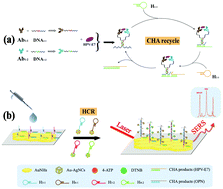A novel SERS biosensor for ultrasensitive detection of HPV-E7 and OPN based on a cascade signal amplification strategy of catalytic hairpin assembly and hybridization chain reaction†
Abstract
Human papillomavirus E7 protein (HPV-E7) and osteopontin (OPN) have been established as critical biomarkers for the early diagnosis of cervical cancer. However, currently there is a lack of highly sensitive and specific ways to detect the two tumor markers. In this work, an ultrasensitive SERS biosensor for the detection of HPV-E7 and OPN was presented based on a cascade signal amplification technique of catalytic hairpin assembly (CHA) and hybridization chain reaction (HCR). HPV-E7-conjugates and OPN-conjugates were used as triggers for the self-assembly process of hairpin DNAs (H1 and H2) into the CHA products. Then, the CHA products activated the HCR by the hybridization between H3-functionalized and H4-functionalized Au–Ag nanocages (Au-AgNCs) and produced long-chain DNA on a gold nano-hexagon (AuNH) array. In this way, lots of Au-AgNCs coupled with a Raman reporter (4-ATP or DTNB) can be attached to the AuNH array. Numerous “hot spots” formed by the adjacent Au-AgNCs as well as AuNH array resulted in a considerable enhancement in SERS signals. Benefiting from the cascade signal amplification strategy, an ultralow detection limit of 0.76 pg mL−1 for HPV-E7 and 0.62 pg mL−1 for OPN within a broad linear range of 1 pg mL−1 to 1 μg mL−1 was achieved. Additionally, the SERS biosensor possesses a high degree of specificity, reproducibility and uniformity. In the detection of clinical blood samples via the proposed method, patients with cervical cancer can be distinguished from normal controls. Therefore, the developed SERS biosensor based on the CHA-HCR amplification technique presents a potentially ideal tool for the early screening of cervical cancer.



 Please wait while we load your content...
Please wait while we load your content...